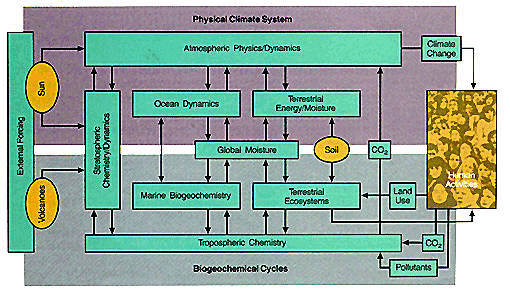
One of the classic diagrams supporting Earth System Science is
that relating fluid and biological Earth processes operating between
the physical climate system and the biogeochemical system, receiving
external energy inputs from the Sun and Earth's internal heat
and subject now to on-going influence from human activities. A
simplified version, known as the Bretherton Diagram, is shown
below.

You are invited to peruse this diagram to gain a feel for how these processes - driven by energy, climate, biogeochemistry, and Man's activities - interrelate.
Biogeochemical Cycles, which depict the flow of important elements
and compounds within the ecosystem as conveyed both by biological
and (geo)physical processes, are summarized below:
One of the key cycles is that of the migration and fixing of carbon
(other geochemical element-based cycles include oxygen, nitrogen,
phosphorus, sulphur, and iron). The next diagram outlines the
main constituents (carbon and its compounds) where they reside
at any one time within the four "spheres". Carbon in the solid
Earth is found mainly in limestones and in petroleum and gas deposits.
Information on the mass balances within the carbon cycle has been
obtained with fair reliability. The exchange of carbon, in units
of 1015 g C yr-1, among the major reservoirs is depicted here.
Carbon dioxide is a critical component in this cycle, being free in the atmosphere, dissolved in the oceans, fixed by plants, and locked into sediments (limestones).
From the above, we sense a hint that Earth System Science deals primarily with matters of climatology and atmospheric physics/chemistry as influenced by essential interactions with the ocean reservoir, water partitioning on the land, biological intakes and effluents, and particles and gases released from volcanoes. Unlike Landsat and similar programs, the emphasis of Earth System Science and its supporting EOS programs has shifted from solid Earth and land use to the environment. If you wish to build up your background knowledge about the major study fields in Earth System Science, check out the Foreword and first seven chapters in the EOS Science Strategy Report (http://eospso.gsfc.nasa.gov/sci_strategy/Foreword.html).
Accelerated global change is, by definition, a global problem. In addition, as we already noted with the example of the SO2 aerosol generated by Mt. Pinatubo. what happens in an apparently far-flung region of our planet has effects that may be felt world-wide. How, then, to address and keep checking on these global concerns?
Code 935, Goddard Space Flight Center, NASA
Written by: Nicholas M. Short, Sr. email: nmshort@epix.net
and
Jon Robinson email: Jon.W.Robinson.1@gsfc.nasa.gov
Webmaster: Bill Dickinson Jr. email: rstwebmaster@gsti.com
Web Production: Christiane Robinson, Terri Ho and Nannette Fekete
Updated: 1999.03.15.